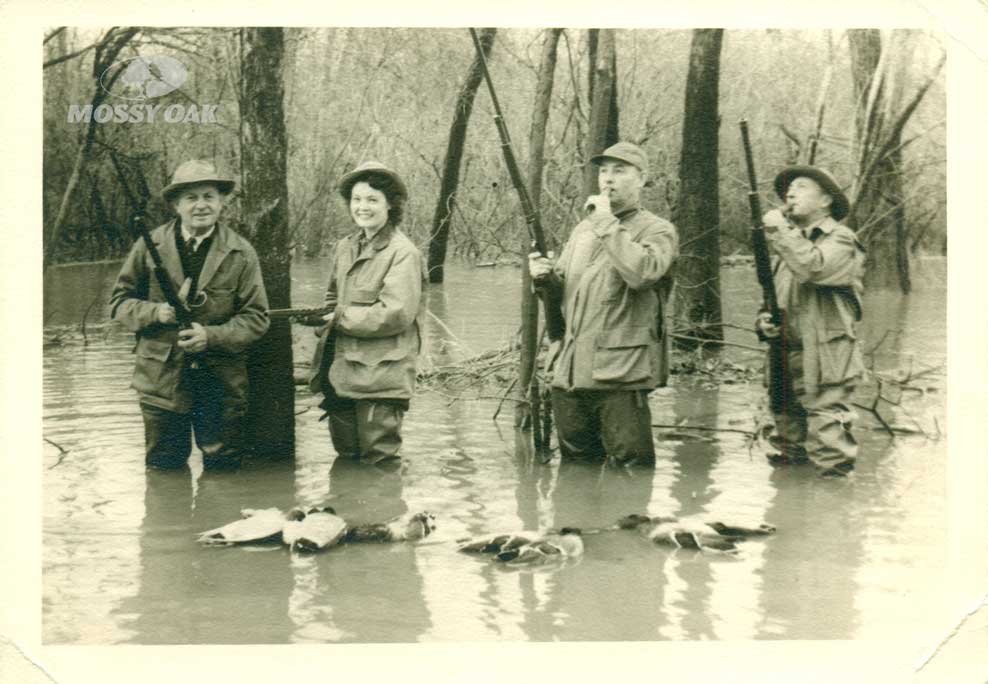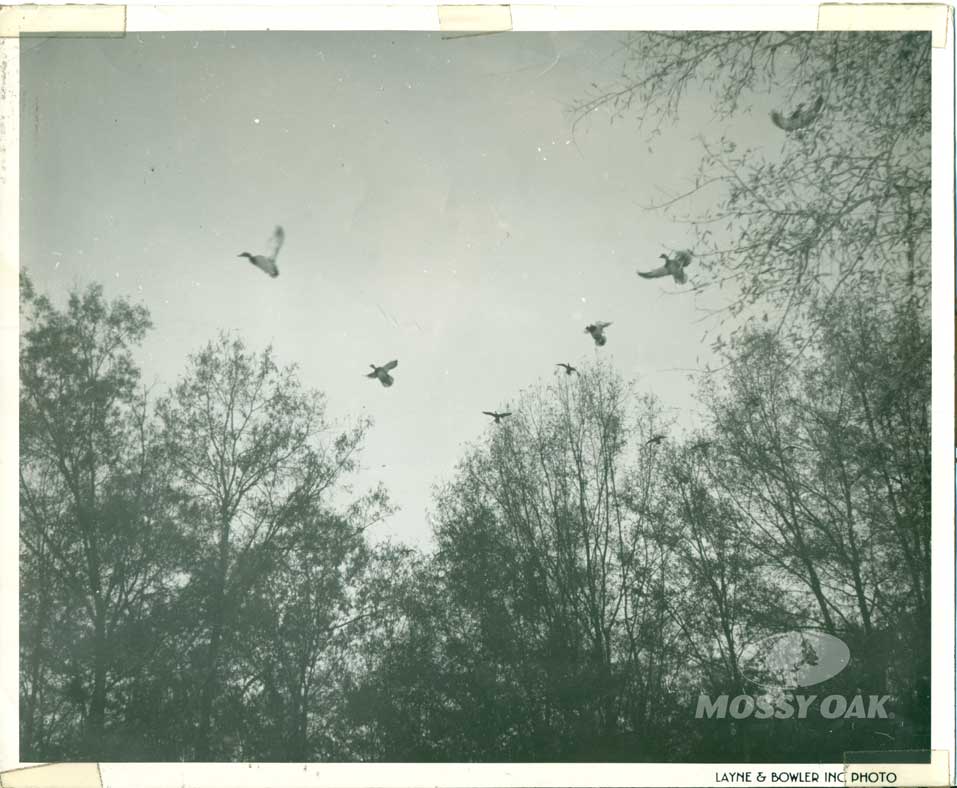Brent Birch

Arkansas is famous for green timber duck hunting as hunters travel from far and wide to have an opportunity of shooting mallard ducks in the trees. These bottomland hardwood forests are impounded then managed with a series of levees and water control structures allowing landowners to manage water at suitable levels for waterfowl. Although the amount of floodable green timber has declined over time, there is still a good amount of flooded timber housing a buffet of groceries for the modern day mallard including acorns from the red oak family and invertebrates, which mallards snack on for protein and calcium.
The following is an excerpt from the book “The Grand Prairie: A History of Duck Hunting’s Hallowed Ground” detailing the early days of green timber duck hunting in Arkansas’s famed Stuttgart region.
The Greentree Revolution
Duck hunting is a lot of things—a family’s legacy, a state’s tradition, a stake of natural culture driven into the ground against the encroachment of time and technology. It’s also big business; the lifeblood of the communities that call the Grand Prairie home and of the state that welcomes thousands of hunters and their accompanying spending every season.
Viewed as a business, duck hunting relies heavily on consistently living up to its reputation season after season. Hunters who go home empty-handed may stay home the next year or at least try other fields in other places, taking their disposable income with them.
Alongside these economic motives lies the ethical mandate humanity bears to preserve and protect wildlife for the enjoyment of succeeding generations—and for the propagation of the species itself.
The state’s conservation and regulatory efforts came about to help maintain Arkansas’s wild spaces. Rather than give Mother Nature unfettered rein, various initiatives sought to temper her example through the resources and ingenuity of mankind. This delicate formula, still not perfected, has proven critical to delivering the kind of habitat that brings back both duck and hunter year after year.
Reservoirs: A Sea Change in Water Management

Ducks’ basic needs—food and water—dictate where birds will congregate. Grand Prairie landowners, and rice farmers in particular, quickly came to understand this foundational equation of ducks’ supply chain management, which led to the creation of flooded fields and the accompanying duck blind-and-decoy style of hunting that came with it.
Over time, landowners with stands of timber marginally suited for agriculture came to recognize this ground as a potential gold mine for attracting the game birds. Rivaling even flooded rice fields in terms of food supply, these stretches of trees provided the additional element of cover.
With suitable water levels, the ducks crammed in among the trees to gorge themselves on fallen acorns, seeds, and plant matter as well as the invertebrates that lived in the decomposing leaves and tree matter on the forest floor.
The problem was, these stretches of timberland didn’t always enjoy consistent flooding and water levels on cue with the arrival of hunters, except in those years of aberrant precipitation. Arkansas’s heaviest rainfall typically happens in late winter and spring outside of duck season, meaning it takes a freak year to cause a waterway to spill over its banks and create naturally flooded timber hunting.
Many years brought no natural overflow at all at the start of duck season, and many more where conditions were less than ideal. Biologist Ken Reinecke compiled historical statistics of White River National Refuge bottomland water levels and found good water conditions for mallards occurred naturally less than sixty percent of the time between 1932 and 1985. Obviously, the hit-and-miss tendencies of Mother Nature were not reliable enough to build a hunting industry around, but it did reveal what could be accomplished in timber given the right conditions.
It was in this mindset that the concept of reservoirs was born on the Grand Prairie, a concept that has been refined here ever since.
The earliest reservoirs were built for agricultural purposes. Raising rice required such massive quantities of water that well drilling quickly dropped the water table and became a very expensive means of irrigation. A reservoir, once filled, helped alleviate that problem and catch rainwater to boot. As these small patches of timberland were generally less valuable than cropland, it was where these reservoirs were often located.
Stuttgart rice farmers, brothers, and businessmen Verne and A.A. “Art” Tindall generally get the credit for the first such reservoir, built in 1927 just outside of Stuttgart. According to a St. Louis Post–Dispatch piece, it occupied a 450-acre tract of timberland around which a twenty-foot trench was dug and the dirt piled up on the outside to form a retaining wall.
Art Tindall claimed in the Post–Dispatch interview that the duo didn’t initially create the reservoir with ducks in mind, but as a means of irrigating 800 acres of rice fields on their 1,800-acre farm. But it soon became apparent that they had stumbled onto an early winning formula.
“When I saw what the ducks were doing, I thought I would make the place a refuge,” Art said. “My plan was to prohibit hunting in the swamp and I figured that such a refuge would make it certain that sportsmen would always have good shooting at nearby lakes and watering places.
However, I found that it was impossible to keep the hunters out. I had watchmen on all sides, but it would have taken the National Guard to protect the place properly and so I decided to commercialize the swamp as a hunting place.”
The presence of hunters did little to dissuade the ducks, who annually descended like locusts on the Tindalls’ man-made waterfowl paradise, especially in dry years. As Verne Tindall said in the Stuttgart Daily Leader, “The first few years, it seemed as if all the ducks in the country tried to get into it.”

J. Roy Stockton wrote of a hunt there in 1931:
“Just then a green-head mallard soared over one of the shooters and his gun barked. It was like the signal for the opening of a war…. Up went the ducks in great swarms, wings roaring and in two minutes the sky was dark with the birds. It was a duck hunter’s dream, a duck hunter’s symphony with wings whirring and guns barking. Birds within range, birds higher up and higher up, big mallard drakes that looked like geese so close were they, and other birds so far up in the sky they looked like insects…. The first shot was fired at 12:15 and at 1:30, most of the shooters had their limits or had used up all their ammunition.”
Such flush harvest brought hunters to the area in droves, each willing to plunk down money for the experience. Permits and premises fees in 1931 included $15 for a nonresident hunting license plus $10 a day to shoot at Tindall Lake ($239 and $159, respectively, in 2016 currency). Arkansas residents paid about $1 for a hunting license.
But almost immediately, these reservoirs showed a distinct flaw; standing water rapidly killed off the very trees the ducks looked to for shelter and acorns. Even as he wrote glowingly of hunting in the ruddy first years of Tindall’s Lake, Stockton also noted in the Post–Dispatch article that water had killed all the trees in the tract soon after the swamp began to form. These reservoirs would come to be known as “dead timber” or “dead tree” reservoirs, one of the biggest examples of which is Peckerwood Lake, the 3,500-acre reservoir built by billionaire Edgar Monsanto Queeny as part of the Wingmead estate.
Stuttgart resident Frank Freudenberg developed a solution to this problem. An early adopter of reservoir building, Freudenberg had experience constructing artificial lakes on his land dating back to 1931. Over the years, he developed a system that allowed a landowner a way to move water from timber to farmland and back again during the course of a year. Freudenberg’s Reservoir, originally known as Maple Island, would become one of the most acclaimed hunting spots on the Grand Prairie and provided a blueprint for those landowners who were interested in building reservoirs specifically to attract ducks (and in some cases secondarily for irrigation purposes). Hence, the greentree reservoir came into being, and by the 1950s was a common sight throughout the Grand Prairie and extended even to the lower states of the Mississippi Flyway.
Continued refinement of processes in step with ongoing study of habitat and species yielded a remarkable understanding of how to manipulate Mother Nature successfully. The best greentree reservoirs share particular attributes, including flat ground comprised of clay-based soils in healthy stands of pin oak trees, providing the ideal combination of food supply and water retention. Short levees allow the critically timed flooding process to reach a consistent depth of twelve to eighteen inches and draining at the close of the season.
“Dabbling ducks, such as mallards, tip up their tails to feed underwater,” wrote Steve Bowman and Steve Wright in Arkansas Duck Hunter’s Almanac. “They don’t completely submerge like diving ducks do. Therefore, any food deeper than their outstretched necks is unavailable to them.
“It’s also well-documented that mallards are attracted to rising waters and the ‘feather edge’ of flooded timber…. Greentree reservoirs permit gradual flooding that attracts ducks over a longer period of time.”































